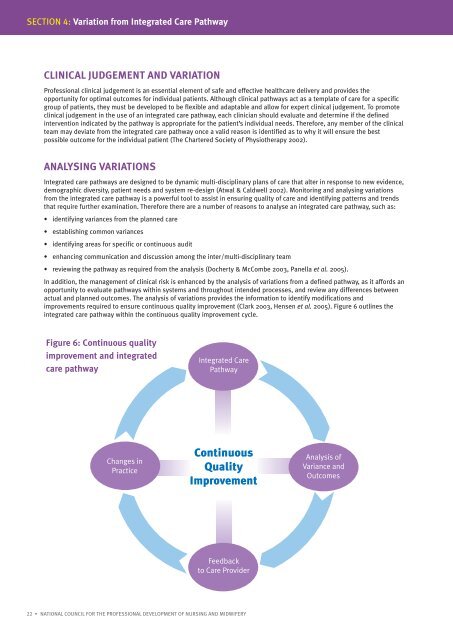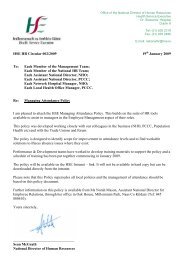Integrated Care Pathways - PNA
Integrated Care Pathways - PNA
Integrated Care Pathways - PNA
- No tags were found...
Create successful ePaper yourself
Turn your PDF publications into a flip-book with our unique Google optimized e-Paper software.
SECTION 4: Variation from <strong>Integrated</strong> <strong>Care</strong> PathwayCLINICAL JUDGEMENT AND VARIATIONProfessional clinical judgement is an essential element of safe and effective healthcare delivery and provides theopportunity for optimal outcomes for individual patients. Although clinical pathways act as a template of care for a specificgroup of patients, they must be developed to be flexible and adaptable and allow for expert clinical judgement. To promoteclinical judgement in the use of an integrated care pathway, each clinician should evaluate and determine if the definedintervention indicated by the pathway is appropriate for the patient’s individual needs. Therefore, any member of the clinicalteam may deviate from the integrated care pathway once a valid reason is identified as to why it will ensure the bestpossible outcome for the individual patient (The Chartered Society of Physiotherapy 2002).ANALYSING VARIATIONS<strong>Integrated</strong> care pathways are designed to be dynamic multi-disciplinary plans of care that alter in response to new evidence,demographic diversity, patient needs and system re-design (Atwal & Caldwell 2002). Monitoring and analysing variationsfrom the integrated care pathway is a powerful tool to assist in ensuring quality of care and identifying patterns and trendsthat require further examination. Therefore there are a number of reasons to analyse an integrated care pathway, such as:• identifying variances from the planned care• establishing common variances• identifying areas for specific or continuous audit• enhancing communication and discussion among the inter/multi-disciplinary team• reviewing the pathway as required from the analysis (Docherty & McCombe 2003, Panella et al. 2005).In addition, the management of clinical risk is enhanced by the analysis of variations from a defined pathway, as it affords anopportunity to evaluate pathways within systems and throughout intended processes, and review any differences betweenactual and planned outcomes. The analysis of variations provides the information to identify modifications andimprovements required to ensure continuous quality improvement (Clark 2003, Hensen et al. 2005). Figure 6 outlines theintegrated care pathway within the continuous quality improvement cycle.Figure 6: Continuous qualityimprovement and integratedcare pathway<strong>Integrated</strong> <strong>Care</strong>PathwayChanges inPracticeContinuousQualityImprovementAnalysis ofVariance andOutcomesFeedbackto <strong>Care</strong> Provider22 • NATIONAL COUNCIL FOR THE PROFESSIONAL DEVELOPMENT OF NURSING AND MIDWIFERY













